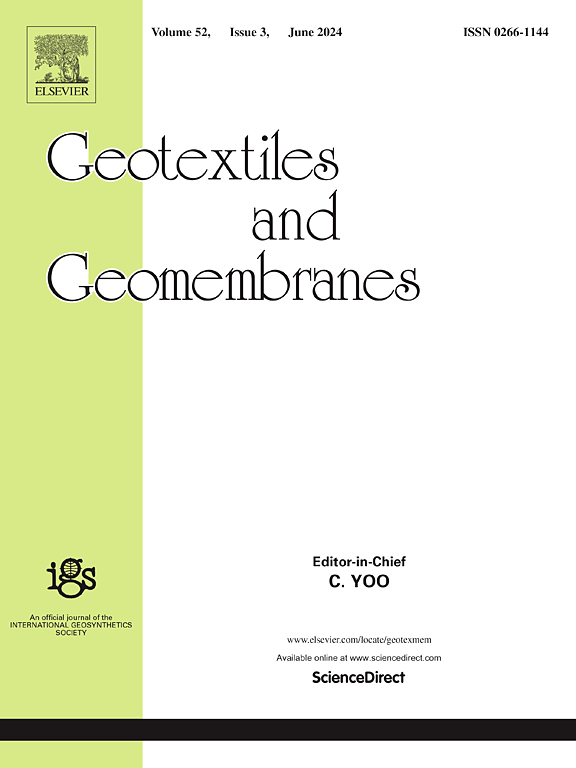天然土工织物对边坡稳定的侵蚀控制性能
IF 6.2
1区 工程技术
Q1 ENGINEERING, GEOLOGICAL
引用次数: 0
摘要
本研究开发了两种创新的基于土工布的边坡稳定和侵蚀控制方法,包括植被-土工布复合材料和碱活性粘合剂(AAB)处理的土工布。在不同的降雨强度和坡度条件下,采用不同的护坡措施来延缓径流的发生、降低侵蚀速率和改善边坡稳定性。研究发现,在强降雨条件下,光秃秃的山坡迅速恶化,从飞溅到严重的沟蚀。植被-土工布系统(高羊茅与椰子纤维毯)大大延迟径流,减少侵蚀,改善土壤结构和保水能力。相比之下,与未经处理的裸坡相比,经aab处理的土工布由于致密的纤维网络和优化的孔隙结构而表现出更好的机械稳定性和抗侵蚀性。此外,aab处理的土工布具有最高的抗侵蚀能力,而植被-土工布复合材料在土壤温度调节和有机质释放方面具有显著的生态效益。因此,将AAB处理与植被土工布系统相结合,可以作为长期的边坡稳定解决方案,同时满足气候变化情景下的工程要求和环境目标。本文章由计算机程序翻译,如有差异,请以英文原文为准。
Erosion control performance of natural geotextiles for slope stabilization
Two innovative geotextile-based slope stabilization and erosion control approaches were developed in this study, including vegetation-geotextile composites and geotextiles treated with alkali-activated binder (AAB). Experimental investigations were conducted to evaluate the effectiveness of different slope protection measures in delaying runoff onset, lowering erosion rates, and improving slope stability under varied rainfall intensities and slope gradients. It was found that bare slopes deteriorated rapidly under high-intensity rainfall, progressing from splash to severe gully erosion. Vegetation-geotextile system (tall fescue with coconut fiber blankets) considerably delayed runoff, decreased erosion, and improved soil structure and water retention. By contrast, AAB-treated geotextiles displayed superior mechanical stability and erosion resistance due to densified fiber networks and optimized pore structures compared to untreated bare slope. Furthermore, AAB-treated geotextiles delivered the highest erosion resistance, while vegetation-geotextile composites provided significant ecological benefits in terms of soil temperature regulation and organic matter release. As a result, integration of AAB treatment with vegetation-geotextile systems can serve as a long-term slope stabilization solution that simultaneously addresses engineering requirements and environmental objectives under climate change scenarios.
求助全文
通过发布文献求助,成功后即可免费获取论文全文。
去求助
来源期刊

Geotextiles and Geomembranes
地学-地球科学综合
CiteScore
9.50
自引率
21.20%
发文量
111
审稿时长
59 days
期刊介绍:
The range of products and their applications has expanded rapidly over the last decade with geotextiles and geomembranes being specified world wide. This rapid growth is paralleled by a virtual explosion of technology. Current reference books and even manufacturers' sponsored publications tend to date very quickly and the need for a vehicle to bring together and discuss the growing body of technology now available has become evident.
Geotextiles and Geomembranes fills this need and provides a forum for the dissemination of information amongst research workers, designers, users and manufacturers. By providing a growing fund of information the journal increases general awareness, prompts further research and assists in the establishment of international codes and regulations.
 求助内容:
求助内容: 应助结果提醒方式:
应助结果提醒方式:


